Details of Ford's New Shelby Cobra
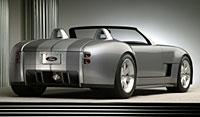 Ford's Shelby Cobra concept signals a possible next step in the blue oval performance lineup |
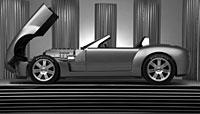 |
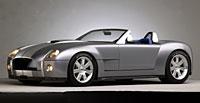 |
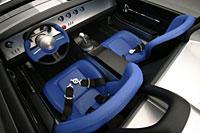 |
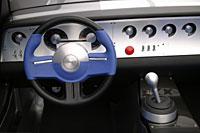 Inside, the Shelby Cobra concept is trimmed mostly in aluminum, with electric blue splashed on the seat trim and steering column. A full-width aluminum instrument panel spans the cockpit in one unbroken swath. |
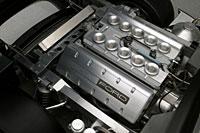 The Shelby Cobra concept's engine has 10 cylinders and is bored and stroked for a 6.4-liter displacement. |
By: Brad Nevin | Ford Communications Network
DETROIT - January 19, 2004: Huge engine, tiny car.
Those are the two founding principles of the Ford Shelby Cobra concept on display in Detroit at the 2004 North American International Auto Show.
It's the foundation motor racing legend Carroll Shelby used when he built the legendary Cobra with a 427-cubic-inch V-8 engine under the hood of a tiny British roadster in 1964. And it’s the formula Ford is using today to build a powerful, fully developed, production-feasible concept car.
Shorter than a Mazda Miata and weighing just more than 3,000 pounds, the Shelby Cobra concept has a 605-horsepower, all-aluminum V-10 engine mounted at the front of an advanced Ford GT-based aluminum chassis.
There is no roof, no side glass and no radio.
"That's the formula," says Shelby. "It's a massive motor in a tiny, lightweight car."
Loosely based on the 4.6-liter, 32-valve V-8 used in the 2004 Mustang Mach I, the Ford Shelby Cobra concept engine has 10 cylinders and is bored and stroked for a 6.4-liter displacement.
"In many ways, it's not very exotic," says Graham Hoare, director for Ford research and advanced engineering. "It uses the same basic castings and assembly techniques as our production modular engine family. The output, though, is phenomenal."
The Shelby Cobra concept's engine has 10 cylinders and is bored and stroked for a 6.4-liter displacement. With a front-mounted engine and a rear-mounted transmission, the Shelby Cobra concept has nearly perfect 50/50 weight distribution and a surprisingly roomy cockpit. Because the transmission is rear-mounted, there is no large center tunnel between the seats. This allows the driver and passenger to sit relatively close to one another, and there is as much front legroom as in a Crown Victoria. Instruments include a 220-mph speedometer, a 10,000-rpm tachometer and critical temperature and pressure readouts.
When a think tank in Dearborn set to designing and engineering the Shelby Cobra concept, they looked to another recently completed project at Ford for ideas – the Ford GT.
"We were planning to use the Ford GT suspension systems, and we asked ourselves how much more of the Ford GT could we borrow," says Manfred Rumpel, manager, advanced product development.
Quite a lot, they discovered.
Key design details include a predominant grille opening. The Shelby Cobra team worked closely with John Coletti, head of engineering for Ford's Special Vehicle Team, to maximize commonality with the Ford GT supercar. The bulk rear structure of the Shelby Cobra concept is made from slightly modified Ford GT components, including the massive cast-aluminum suspension nodes, the rear rails and bumper beam, a major cross member and the brackets used to mount the transmission to the car. The center portion of the space frame also has a high level of commonality with the Ford GT, as its major aluminum extrusions are based heavily on existing pieces.
Even though it shares many parts with the Ford GT, the Shelby Cobra concept is more than two feet shorter with a wheelbase that is nearly seven inches shorter. Comparatively small proportions like this gave designers the chance to create a body that is tightly wrapped around its engine and chassis.
"We let the powertrain, the space frame and the suspension dictate the architecture for the body," says Richard Hutting, chief designer. "And the result was a very modern and desirable shape that doesn't share a single dimension or proportion with the original Shelby Cobra."
Inside, the Shelby Cobra concept is trimmed mostly in aluminum, with electric blue splashed on the seat trim and steering column. A full-width aluminum instrument panel spans the cockpit in one unbroken swath. Key design details include a predominant grille opening, vertical bumper bars, the side air intake, a powerful bulge over each wheel and stacked lamps in the front and rear. Because the engine sits rearward of the front wheels, the concept's front overhang is short. An equally short rear overhang gives the Shelby Cobra concept a short 100-inch wheelbase. These proportions instantly communicate rear-wheel-drive power and serious performance. The stance of the car on the road is unmistakably powerful and sure-footed. More subtle design touches include no windshield wipers, no side windows and no convertible top.
Those wishing fair-weather, fast driving on open roads need only apply.
"When you're setting out to tell a story about an automobile in a fresh, contemporary way, you're not actually looking to create beauty – you're looking to create meaning," says J Mays, Ford Motor Company group vice president, design. "We have interpreted that ass-kicking Cobra attitude in a very modern way."
The Shelby Cobra concept was built in just five months at a relatively low cost by a select group of Ford enthusiasts in Dearborn, Mich. It's a fully developed and engineered racing roadster that represents the best modern racing technology Ford has to offer today. When parked next to the all-new Ford GT supercar and the redesigned 2005 Mustang coupe, the Shelby Cobra concept completes a trilogy of legendary Ford performance vehicles and signals what might be a next step for the blue oval.


